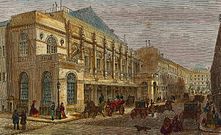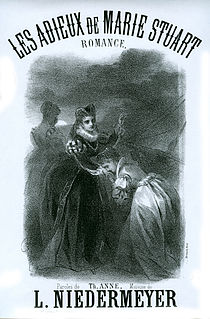- Marie Stuart (opera)
-
Marie Stuart is a grand opera in five acts composed by Louis Niedermeyer to a libretto by Théodor Anne loosely based on events in the life of Mary, Queen of Scots. It premiered at the Théâtre de l'Académie Royale de Musique in Paris on 6 December 1844 with Rosine Stoltz in the title role.
Contents
Background and performance history
 Théâtre de l'Académie Royale de Musique where Marie Stuart premiered in 1844
Théâtre de l'Académie Royale de Musique where Marie Stuart premiered in 1844
Marie Stuart was Niedermeyer's fourth opera and his second foray into the grand opera genre. Although some sources, e.g. Gallo (2011), have written that the libretto is based on Friedrich Schiller's 1800 play, Mary Stuart, this provenance does not appear in the libretto published in 1845 or the synopsis published in 1844, and the opera is quite different from the play. Schiller's play depicts only the last two days in the life of Mary, Queen of Scots while the opera spans the period from 1561 to 1587 with the setting moving from France to Scotland and finally to England.[1] Niedermeyer composed the score in less than a year, and the work premiered on 6 December 1844 at the Théâtre de l'Académie Royale de Musique with King Louis Philippe in attendance.[2] The production was designed by Philastre and Cambon and directed by Jean Coralli who also choreographed the ballet divertissement for Act 3.[1] The ballet, starring Adèle Dumilâtre, was presented as a performance attended by Mary Stuart at her palace. Like many such ballets in the golden age of grand opera, it also served a dramatic function within the opera itself. Its theme, the triumph of Esther over the fallen queen Vashti, echoes Mary Stuart's hopes that she would triumph over Queen Elizabeth.[3]
After the premiere, Niedermeyer was made a Chevalier (Knight) of the French Legion of Honour, but Marie Stuart had only a modest success.[4] It remained in the repertoire of the Paris Opera with some cuts to the score until 1846, after which it was largely forgotten. It was, however, revived in Stuttgart in 1877 (performed in German translation), and extracts from the work were performed by Zurich Opera at the 2002 Festival della Valle d'Itria in Italy.[2] Several pieces from the opera were published separately and were frequently performed in concerts and recitals. The most notable of these was Marie's aria in Act 1 where she bids her farewell to France, "Déjà la nuit s'avance" (also known as "Les adieux de Marie Stuart").[5] It was performed in recitals by both male and female singers in the 19th century and continues to be performed today. It was also published in various arrangements for solo instrument including violin, piano, and flute.
Roles
Role Voice type Premiere Cast, 6 December 1844
Conductor:Mary Stuart mezzo-soprano Rosine Stoltz Earl of Bothwell, Mary Stuart's 3rd husband tenor Italo Gardoni James, Earl of Moray, Mary Stuart's half-brother baritone Paul Barroilhet Lord Ruthven bass Nicolas Levasseur Henry Stuart, Lord Darnley, Mary Stuart's 2nd husband bass Armando Latour Elizabeth, Queen of England soprano Julie Dorus-Gras Cecil, Baron Burghley, Queen Elizabeth's minister bass Jacques-Émile Serda David Rizzio, Mary Stuart's private secretary Martin George Douglas, Mary Stuart's page soprano Marie-Dolorès Nau (en travesti) Sir Hamilton, governor of Loch Leven Castle baritone Ferdinand Prévôt Robert Melville, administrator of Mary Stuart's palace baritone Canaple Lord Seyton, an ally of Mary Stuart bass Louis-Henri Obin Randolph, an English officer Molinier Earl of Morton bass Brémont Mary Fleming, Mary Stuart's lady-in-waiting Éléonore Duclos Anna Kennedy, Mary Stuart's companion mezzo-soprano Sophie Méquillet Douglas, a Scottish lord Octave Huntley, a Scottish lord bass Joseph Menghis Athol, a Scottish lord bass Jacques-Émile Serda Gordon, a Scottish lord Koenig Scottish and English nobles, soldiers, people of France and Scotland See also
- Cultural depictions of Mary, Queen of Scots
- Stradella, Niedermeyer's first grand opera
References
- Notes
- ^ a b Anne (1845) p. 1
- ^ a b Garo (2011)
- ^ Charlton (2003) p. 100
- ^ Fétis (1864) p.320
- ^ Not to be confused with Richard Wagner's setting of Pierre-Jean de Béranger's poem "Les adieux de Marie Stuart".
- Sources
- Académie Royale de Musique (1844). Marie Stuart: opéra en 5 actes (synopsis). F. Malteste (Paris) (French)
- Anne, Théodore (1845). Marie Stuart: opéra en 5 actes (libretto). C. Tresse (Paris) (French)
- Casaglia, Gherardo (2005). "Niedermeyer". Almanacco Amadeus (Italian)
- Charlton, David (2003). The Cambridge Companion to Grand Opera. Cambridge University Press. ISBN 0521646839
- Fétis, François-Joseph (1864). "Niedermeyer (Louis)", Biographie universelle des musiciens et bibliographie génèrale de la musique, Volume 6, 2nd edition. Firmin-Didot
- Garo, Edouard (2011), L'oeuvre de Louis Niedermeyer. Association Niedermeyer Nyon. (French)
Categories:- Operas by Louis Niedermeyer
- French-language operas
- Grand operas
- 1844 operas
- Operas
- Paris Opera world premieres
Wikimedia Foundation. 2010.

